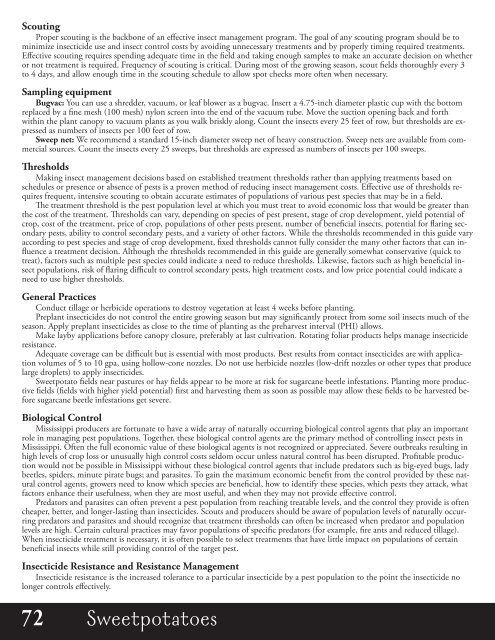Agronomic Crops
mJyPrJ
mJyPrJ
Create successful ePaper yourself
Turn your PDF publications into a flip-book with our unique Google optimized e-Paper software.
scouting<br />
Proper scouting is the backbone of an effective insect management program. e goal of any scouting program should be to<br />
minimize insecticide use and insect control costs by avoiding unnecessary treatments and by properly timing required treatments.<br />
Effective scouting requires spending adequate time in the field and taking enough samples to make an accurate decision on whether<br />
or not treatment is required. Frequency of scouting is critical. During most of the growing season, scout fields thoroughly every 3<br />
to 4 days, and allow enough time in the scouting schedule to allow spot checks more often when necessary.<br />
sampling equipment<br />
Bugvac: You can use a shredder, vacuum, or leaf blower as a bugvac. Insert a 4.75-inch diameter plastic cup with the bottom<br />
replaced by a fine mesh (100 mesh) nylon screen into the end of the vacuum tube. Move the suction opening back and forth<br />
within the plant canopy to vacuum plants as you walk briskly along. Count the insects every 25 feet of row, but thresholds are expressed<br />
as numbers of insects per 100 feet of row.<br />
sweep net: We recommend a standard 15-inch diameter sweep net of heavy construction. Sweep nets are available from commercial<br />
sources. Count the insects every 25 sweeps, but thresholds are expressed as numbers of insects per 100 sweeps.<br />
resholds<br />
Making insect management decisions based on established treatment thresholds rather than applying treatments based on<br />
schedules or presence or absence of pests is a proven method of reducing insect management costs. Effective use of thresholds requires<br />
frequent, intensive scouting to obtain accurate estimates of populations of various pest species that may be in a field.<br />
e treatment threshold is the pest population level at which you must treat to avoid economic loss that would be greater than<br />
the cost of the treatment. resholds can vary, depending on species of pest present, stage of crop development, yield potential of<br />
crop, cost of the treatment, price of crop, populations of other pests present, number of beneficial insects, potential for flaring secondary<br />
pests, ability to control secondary pests, and a variety of other factors. While the thresholds recommended in this guide vary<br />
according to pest species and stage of crop development, fixed thresholds cannot fully consider the many other factors that can influence<br />
a treatment decision. Although the thresholds recommended in this guide are generally somewhat conservative (quick to<br />
treat), factors such as multiple pest species could indicate a need to reduce thresholds. Likewise, factors such as high beneficial insect<br />
populations, risk of flaring difficult to control secondary pests, high treatment costs, and low price potential could indicate a<br />
need to use higher thresholds.<br />
General Practices<br />
Conduct tillage or herbicide operations to destroy vegetation at least 4 weeks before planting.<br />
Preplant insecticides do not control the entire growing season but may significantly protect from some soil insects much of the<br />
season. Apply preplant insecticides as close to the time of planting as the preharvest interval (PHI) allows.<br />
Make layby applications before canopy closure, preferably at last cultivation. Rotating foliar products helps manage insecticide<br />
resistance.<br />
Adequate coverage can be difficult but is essential with most products. Best results from contact insecticides are with application<br />
volumes of 5 to 10 gpa, using hollow-cone nozzles. Do not use herbicide nozzles (low-drift nozzles or other types that produce<br />
large droplets) to apply insecticides.<br />
Sweetpotato fields near pastures or hay fields appear to be more at risk for sugarcane beetle infestations. Planting more productive<br />
fields (fields with higher yield potential) first and harvesting them as soon as possible may allow these fields to be harvested before<br />
sugarcane beetle infestations get severe.<br />
Biological Control<br />
Mississippi producers are fortunate to have a wide array of naturally occurring biological control agents that play an important<br />
role in managing pest populations. Together, these biological control agents are the primary method of controlling insect pests in<br />
Mississippi. Often the full economic value of these biological agents is not recognized or appreciated. Severe outbreaks resulting in<br />
high levels of crop loss or unusually high control costs seldom occur unless natural control has been disrupted. Profitable production<br />
would not be possible in Mississippi without these biological control agents that include predators such as big-eyed bugs, lady<br />
beetles, spiders, minute pirate bugs; and parasites. To gain the maximum economic benefit from the control provided by these natural<br />
control agents, growers need to know which species are beneficial, how to identify these species, which pests they attack, what<br />
factors enhance their usefulness, when they are most useful, and when they may not provide effective control.<br />
Predators and parasites can often prevent a pest population from reaching treatable levels, and the control they provide is often<br />
cheaper, better, and longer-lasting than insecticides. Scouts and producers should be aware of population levels of naturally occurring<br />
predators and parasites and should recognize that treatment thresholds can often be increased when predator and population<br />
levels are high. Certain cultural practices may favor populations of specific predators (for example, fire ants and reduced tillage).<br />
When insecticide treatment is necessary, it is often possible to select treatments that have little impact on populations of certain<br />
beneficial insects while still providing control of the target pest.<br />
Insecticide Resistance and Resistance Management<br />
Insecticide resistance is the increased tolerance to a particular insecticide by a pest population to the point the insecticide no<br />
longer controls effectively.<br />
72 Sweetpotatoes


